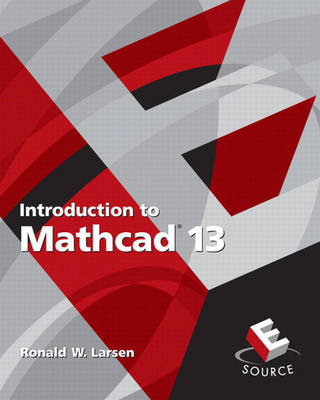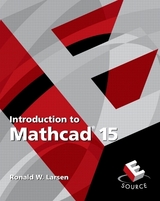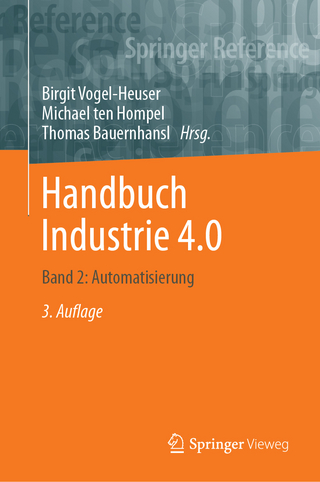
Introduction to MathCAD 13
Pearson (Verlag)
978-0-13-189073-2 (ISBN)
- Titel erscheint in neuer Auflage
- Artikel merken
ESource–Prentice Hall's Engineering Source–provides a complete, flexible introductory engineering and computing program. ESource allows professors to fully customize their textbooks through the ESource website. Professors are not only able to pick and choose modules, but also sections of modules, incorporate their own materials, and re-paginate and re-index the complete project. http://www.prenhall.com/esource
1 • MATHCAD: THE ENGINEER’S SCRATCH PAD 1
1.1 Introduction to Mathcad 1
1.2 Mathcad as a Design Tool 1
1.3 Mathcad as a Mathematical Problem Solver 7
1.4 Mathcad as a Unit Converter 7
1.5 Mathcad for Presenting Results 8
1.6 Mathcad’s Place in an Engineer’s Tool Kit 8
1.7 What’s New in Mathcad 13? 9
1.8 Conventions Used 10
Key Terms 10
Problems 10
2 • MATHCAD FUNDAMENTALS 12
Nanotechnology 12
2.1 The Mathcad Workspace 13
2.2 Controlling the Order of Solving Equations in Mathcad 15
2.3 Four Different Kinds of Equal Signs! 16
2.4 Entering an Equation 19
2.5 Modifying an Equation 25
2.6 Working with Units 33
2.7 Controlling How Results are Displayed 40
2.8 Entering and Editing Text 45
2.9 A Simple Editing Session 49
2.10 Saving Your Worksheets 51
Summary 55
Mathcad Summary 55
Key Terms 57
Problems 57
3 • MATHCAD FUNCTIONS 69
Optics 69
3.1 Mathcad Functions 70
3.2 Elementary Mathematics Functions and Operators 70
3.3 Trigonometric Functions 73
3.4 Functions for Handling Complex Numbers 77
3.5 Advanced Mathematics Functions 78
3.6 String Functions 87
3.7 User-Written Functions 88
Summary 91
Mathcad Summary 91
Key Terms 93
Problems 93
4 • WORKING WITH MATRICES 104
Total Recycle 104
4.1 Mathcad’s Matrix Definitions 105
4.2 Defining a Matrix 106
4.3 Matrix Math Operations 110
4.4 Solving Systems of Linear Algebraic Equations 115
4.5 Array Functions 120
4.6 Modifying Matrices 123
4.7 Additional Ways to Initialize Arrays 130
Summary 143
Mathcad Summary 143
Key Terms 144
Problems 144
5 • DATA ANALYSIS FUNCTIONS 155
Risk Analysis 155
5.1 Graphing with Mathcad 155
5.2 Statistical Functions 173
5.3 Interpolation 177
5.4 Curve Fitting 182
Summary 199
Mathcad Summary 199
Key Terms 201
Problems 201
6 • PROGRAMMING IN MATHCAD 213
New Energy Sources 213
6.1 Mathcad Programs 213
6.2 Writing a Simple Program 214
6.3 The Programming Toolbar 216
6.4 Program Flowcharts 217
6.5 Basic Elements of Programming 220
Summary 257
Key Terms 259
Problems 259
7 • MATHCAD’S SYMBOLIC MATH CAPABILITIES 269
Composite Materials 269
7.1 Symbolic Math with Mathcad 269
7.2 Solving an Equation Symbolically 273
7.3 Manipulating Equations 275
7.4 Polynomial Coefficients 281
7.5 Symbolic Matrix Math 282
7.6 Symbolic Integration 285
7.7 Symbolic Differentiation 294
Summary 300
Mathcad Summary 301
Key Terms 302
Problems 303
8 • NUMERICAL TECHNIQUES 310
Engineering in Medicine 310
8.1 Iterative Solutions 310
8.2 Numerical Integration 317
8.3 Numerical Differentiation 330
Summary 338
Mathcad Summary 339
Key Terms 339
Problems 340
9 • USING MATHCAD WITH OTHER PROGRAMS 347
9.1 Introduction 347
9.2 Mathcad and Microsoft Word 347
9.3 Mathcad and Microsoft Excel 349
9.4 Mathcad and Matlab 374
Summary 376
Problems 378
| Erscheint lt. Verlag | 4.10.2006 |
|---|---|
| Sprache | englisch |
| Maße | 253 x 254 mm |
| Gewicht | 844 g |
| Themenwelt | Informatik ► Weitere Themen ► CAD-Programme |
| Technik | |
| ISBN-10 | 0-13-189073-5 / 0131890735 |
| ISBN-13 | 978-0-13-189073-2 / 9780131890732 |
| Zustand | Neuware |
| Informationen gemäß Produktsicherheitsverordnung (GPSR) | |
| Haben Sie eine Frage zum Produkt? |
aus dem Bereich



